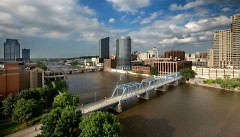The flood of April 2013, which damaged hundreds of homes and threatened Grand Rapids’ downtown core, qualified the community as a candidate for the U.S. Department of Housing and Urban Development (HUD) $800 million National Disaster Resilience Competition in 2014. At the close of last month, the grant was awarded—to other applicants.
The proposal submitted by the City of Grand Rapids, Kent County, and Downtown Grand Rapids Inc.—the Grand Strategy—was named a finalist in the 16-month competition in June 2015. Last month, the HUD grant was awarded to 13 of the 67 participating U.S. Communities. Unfortunately, the Grand River community was not one of them.
The Grand Strategy requested $233 million of federal aid, to be matched by $320 million from other local stakeholders, donors—and potentially the state—with the aim of achieving restoration of the Grand River and reintegration of the communities along its banks.
Restoration of the Grand River is a goal that has been floating around for years. The plan to return the historic rapids to the river was adopted by the Green Grand Rapids Master Plan in the fall of 2011—two years before the devastating flood. Since then, the goal of restoration has been swept up in the GR Forward Initiative, alongside revitalization goals for the downtown communities, and most recently in the Grand Strategy proposal.
Last month, Kent County, Grand Rapids, and Downtown Grand Rapids Inc. issued a joint statement in response to the decision, conveying disappointment with the result, but gratitude for the opportunity to pitch the Grand Strategy.
Though not equal to the hard-sought $200 million, the value of the collaboration established as a result of the Competition “will yield incalculable benefits for this region as we move forward together—stronger.” Whatever the next step is, it will be backed by the extensive and—more importantly—collaborative planning and organizational work that went into the original proposal.
“We’ve built something great: a highly collaborative team that will yield results on many projects in the future and make our region more resilient to natural disasters and an even better place to live, raise families and grow businesses.”
The Rapidian, a program of the 501(c)3 nonprofit Community Media Center, relies on the community’s support to help cover the cost of training reporters and publishing content.
We need your help.
If each of our readers and content creators who values this community platform help support its creation and maintenance, The Rapidian can continue to educate and facilitate a conversation around issues for years to come.
Please support The Rapidian and make a contribution today.
